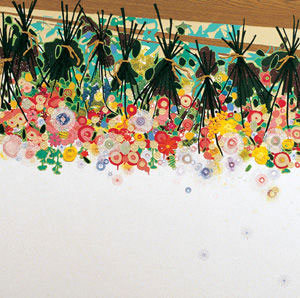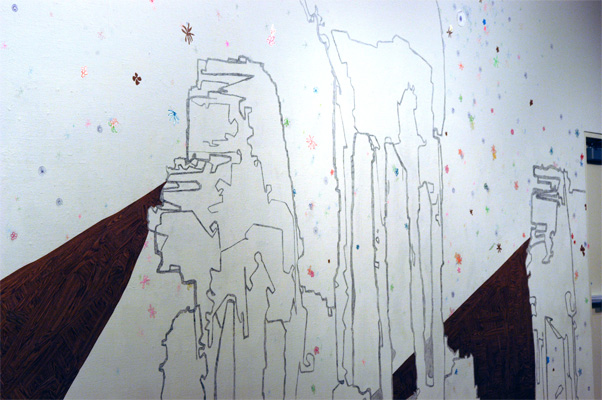Essay: Stuff I made in my couch fort and my continuing obsession with Bridget Riley
Kris Douglas' essay on Scott Stulen's Stuff I made in my couch fort and my continuing obsession with Bridget Riley.




Cultural or shared memory, based on relationships specific to images, politics, texts or other popular media, has the distinct capacity to develop into fiction or fabrication, eschewing an impartial “truth” and creating subjective narrative forms. Based on these conditional cultural creations, how does one differentiate between an “authentic” memory and the “constructed,” and recognize the impact this consideration has on our reading of history and understanding of the individual’s place within? In the text Postproduction: Culture as Screenplay/How Art Reprograms the World, author Nicholas Bourriaud states: ” It is no longer a matter of elaborating a form on the basis of a raw material but working with objects that are already in circulation on the cultural market, which is to say, objects already informed by other objects. Notions of originality (being at the origin of) and even of creation (making something from nothing) are slowly blurred in this new cultural landscape marked by the twin figures of the DJ and the programmer, both of whom have the task of selecting cultural objects and inserting them into new contexts.” 1
In the same manner as a DJ, many artists working today opt to combine, recombine, and invent new environments where once-isolated images, forms and concepts coalesce and create new relationships, emphasizing a position that, until that moment, was unrealized. These subjective amalgamations have the ability to restructure the ideas and feelings of the viewer, bringing into focus varying perspectives and challenging the notion of a singular or unidimensional experience. The overall recontextualizing and restructuring of cultural information (e.g. photography, the cinema, pop cultural events and images) and the lucid or vague personally-imbued memories of any of the above, becomes a fascinating if not contentious point of departure for the contemporary arts.
Our current media-rich culture, which increasingly utilizes the Internet and other technological means of connection and information gathering, facilitates exposure and access to copious amounts of images, ideas, and information. These seemingly limitless resources can be accessed to inform art production, whether the artist aims to comment on the current socio-political or international economic condition, or on a fond recollection of the Ewoks slamming two trees into the side of an Imperial Walker in the forest of Endor. In terms of created images available for use, interpretation, or re-presentation, each can be equally valid in characterizing or documenting a shared experience and developing a connection between creator, audience, and culture. Scott Stulen explores the process of combining representations of personal memories with popular culture events and images and considers how this remix has the capacity to alter memory and interpretation of personal experience.
Similar to the multidimensional nature of information and memory retrieval, Scott Stulen works in a variety of media to present to the viewer his concepts and aesthetic interests. Frequently working in wall-based drawing and video installation, Stulen’s large-scale works invite the viewer to become a component of an environmental condition, encouraging interaction both visually and physically. In doing so, he effectively exploits the inherent spatial and formal characteristics of installation-based artwork. Typically, the images selected and altered for inclusion or those inspiring new constructions become recognizable to the viewer after close inspection. In combining both referential (e.g., familiar images) and created images in a new system, Stulen succeeds in providing the viewer an entry point into the understanding of this multi-layered approach.
For example, in Stulen’s work There’re too many nerds on the internet or I fell into a trap set by Muppets, he isolates a particular portion of the film Return of the Jedi and allows for many associations and meanings inherent in the overall cinematic experience as they pertain to shared or cultural meaning. This momentary image condenses and characterizes the age-old theme of good versus evil and the quest of the righteous, a narrative subject that is communicated, elaborated, and reconceptualized in various forms over time and across multiple cultures (e.g., Joseph Campbell’s hero cycle → George Lucas’ Star Wars Trilogy → Stulen’s installation). A linear path is not necessary, however, and each artist or individual recreates and reinterprets the underlying concept, most likely influenced by memory, personal history, and predominant cultural aspects of the time. Stulen selects an image of the teddy bear-like Ewoks out-witting the technologically advanced Imperial troops, demonstrating the power of the “good” over the morally corrupt and overpowering. Presumably this was an exhilarating experience for Stulen, as it was/is for millions of others, to witness this in film. By representing this culturally-loaded image within an installation format, Stulen allows the viewer to reconsider meaning within a new context.
But it is not a singular or isolated connection that Stulen wishes the audience to make. Nor does his work represent only grandiose concepts (i.e. triumph of good versus evil). Whimsical and somewhat humorous theories are represented—images and ideas that may originate in some form from Stulen’s childhood or personal history. For example, Stulen chooses to use wood-grain adhesive vinyl, which is found in the home for a variety of uses especially in the “cabin culture” of Minnesota. What is considered an appropriate if not aesthetically required material for some (why not choose fake wood to match other fake wood?) to line shelves for a pseudo-natural match to faux-wood paneling becomes an equally acceptable material to utilize in the production of the final work. Combining all of these elements into a singular work—multiple considerations based on numerous connections, memories, and histories—Stulen directs the audience into an environment where anything can, or does, matter. The key lies in the act of choosing, and through his thoughtful and intelligent organization of materials, Stulen clearly exhibits an ability to make meaningful choices that impact the audience—like a good DJ.
Notes:
1 Nicolas Bourriaud, Postproduction, Lukas & Sternberg, New York